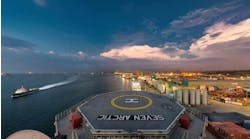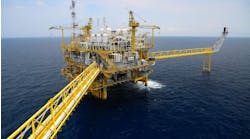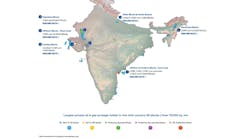Bruce Beaubouef
Managing Editor
Russell McCulley
Senior Technical Editor
With a registered attendance of nearly 2,700, the 2013 Subsea Tieback Forum & Exhibition held March 5-7 in San Antonio hosted "nearly 90% of the world's oil and gas subsea professionals," observed Bob Writt of BHP Billiton, chairman of this year's conference advisory board.
With most of the world's subsea experts under one roof, attendees were able to get the latest updates on key issues, including insights on subsea boosting and processing, riser technology, well containment systems, and flow assurance.
With a carefully crafted conference agenda developed by the Subsea Tieback advisory board, delegates benefited from hearing the lessons learned and best practices developed by the speakers and their companies.
And with 14 of the 18 technical presentations offered by offshore operating companies, attendees were treated to first hand experiences and insights attained from today's subsea oil and gas frontiers.
On Tuesday evening, attendees networked on the floor of the accompanying exhibition for a networking reception, where some 215 exhibiting companies presented the latest in subsea technology and offshore services.
Opening plenary
The conference kicked off the morning of Wednesday, March 6, with addresses from Nigel Smith, president of development for BHP Billiton Petroleum, and Tyler Schilling, president and co-founder of Schilling Robotics.
Keen interest among engineers and exhibitors alike are signs of a booming offshore industry. But some familiar challenges remain, as Smith pointed out in the keynote address. Most significant are the rapidly accelerating costs of exploration and project development, along with slimmer success rates, that have made it more difficult to achieve commercial and technical success in deepwater.
The rapid rise of unconventional gas in the US has had a profound effect on the industry, Smith noted, as a number of major operators expand their shale gas portfolios. BHP Billiton is among them, having shored up extensive holdings in the Eagle Ford and Permian Basin shale plays in Texas, among others. But the company is also seeking growth offshore, with the Shenzi and Neptune developments in the deepwater Gulf of Mexico and the Macedon gas project offshore
Western Australia, a $1.5-billion, 200-MMcf/d capacity development scheduled for first production later this year.
Smith cited an average two-year wait for delivery of subsea equipment as one factor that makes it difficult for operators to reach target dates. And he called for a greater emphasis on quality and "repeatability" among suppliers to help the industry achieve production goals.
Schilling, in keeping with this year's conference theme, "Take it to the Limit," gave several examples of how innovation has helped overcome technology barriers, often in a startlingly short time: the development of artificial lighting from candles to energy-saving bulbs, for example, or the dramatic cut in auto emissions over the past few decades. Productivity over the last century, too, has fueled unprecedented growth, he said.
Schilling Robotics, now a division of FMC Technologies, is developing ROV manipulator arms that extend the use of station-keeping technology to all aspects of the device. Early next year, the company plans to introduce new technology that will allow a manipulator to grasp a tool on command, and research is underway that enables the manipulator arm to track a moving object and orient itself automatically, freeing the ROV operator to concentrate on the task at hand and the "four degrees of freedom" used to navigate the ROV. The goal, he said, is a system so simplified and automated that many subsea ROV operations will one day require only basic training and skills.
Technical presentations
Following the opening plenary presentations, the first session on Wednesday morning focused on inspection, repair, and maintenance of subsea systems. A presentation by Sergio Porciuncula of Petrobras America Inc. focused on a problem experienced with a free-standing hybrid riser on the Cascade & Chinook project in 2011. Porciuncula discussed how an emergency response plan was implemented and successfully executed to secure the safety of personnel and the environment; and how production was eventually resumed on both fields. The presentation, which drew a record crowd of 500-plus attendees, won the award for "Best Presentation" at the Subsea Tieback forum.
Shell's Michiel Bekker discussed the challenges of replacing failed caisson-ESPs in the deepwater BC-10 field offshore Brazil using a semisubmersible drilling rig, and provided lessons learned from that effort. Karl Schnakenburg of BHP Billiton discussed corrosion problems and rectification efforts on the MPFM hub, a recent subsea development project that required intervention and remediation.
Session two examined the latest trends in subsea boosting and processing. Nils Arne Soelvik of Framo Engineering discussed wet gas compressor development and testing. His presentation examined the latest developments in multi-phase compressor technology; its impact on the system solution; the technical qualification program to commercialize it; and the results of the testing.
Ashish Karamchandani of Chevron discussed the challenges, strategies, and accomplishments of the Jack & St. Malo subsea pumping system. He noted that Jack & St. Malo project, located in the deepwater GoM, will require subsea single-phase pressure boosting. Because subsea pumping is an area of new technology for Chevron, Karamchandani noted that an extensive technology development program was carried out, followed by a contract to deliver three subsea boosting systems.
Next, electrical submersible pumps on the BC-10 project were once again a presentation topic. This time Francisca Ogundele of Shell Brasil Petróleo focused on the Phase I caisson ESP operating experience. She focused on the challenges facing the Shell BC-10 subsea field operations and surveillance team in operating caisson ESPs. Ogundele, who won the award for "Best Presenter" at the Subsea Tieback forum, focused on best practices for maintaining high ESP availability while at the same time maximizing production from the wells.
Session three on Wednesday focused on project learnings, with presentations from Shell Exploration & Production Co., Husky, and Chevron officials. Larry Obst of Shell discussed lessons learned from the startup and early operations on the Perdido subsea system. Jason Kemshall of Husky reviewed the system challenges faced on the Husky White Rose project, including ice-related threats; and discussed the applicability of these lessons to development in other arctic regions. Edward Nakajima of Chevron Energy Technology Co. discussed the ways in which new technologies can be applied to a riser tower installation, based on lessons learned from the few installed to date.
On Thursday morning, the conference opened to well containment, a topic of high importance to the offshore industry. Martin W. Massey of the Marine Well Containment Co. discussed his company's recent capping stack demonstration in the US Gulf of Mexico, while Roger Scheuermann of Helix Well Containment Group discussed the evolution of his company's well containment system (more on this below). Jonathan Shipley of Petrobras America Inc. discussed the ways in which his company uses existing subsea infrastructure in its containment response plans.
After focusing on well containment in the early morning, the conference turned its attention to pipelines and flowlines, with presentations from BP, Chevron, and RiserTec. The Cascade & Chinook project was once again a focus of attention as Craig Masson of RiserTec examined layout considerations for free-standing hybrid risers in the Gulf of Mexico. John Lawson of Chevron discussed the latest advances in subsea wet insulation research, including an update on the JIP which has been testing wet insulation and field joint material for use in subsea applications. Maria Nass of BP concluded the session with an examination of the ways in which computational fluid dynamics can be used to improve cool down time in subsea pipelines, and discussed how the recently installed Galapagos in-line sled facilitated throughput.
The final session of the conference focused on recent technology innovations, and featured presentations from Chevron, ConocoPhillips, and Anadarko. Peter Batho of Chevron Energy Technology Corp. explored the current state of technology, and discussed ways to rationalize and optimize subsea compression systems to minimize footprint, weight, and complexity. Trey Gilbert of ConocoPhillips presented the results of a case study which involved a 40-km (25-mi) subsea tieback to a six-zone intelligent well completion system. Mike Beattie of Anadarko Petroleum Corp. discussed the design, fabrication, and installation of steel lazy wave risers on the Caesar-Tonga project, which represented the first application of this technology in the Gulf of Mexico and the first tieback to a spar floating platform.
Marine well containment
The Wednesday morning technical sessions opened with a focus on emergency well containment systems, a topic of keen interest to SSTB attendees and the industry at large. Conference delegates learned how both the Marine Well Containment Co. and Helix Well Control Group have been working to expand their deepwater well control systems to accommodate greater depths, higher pressures and bigger oil and gas volumes.
The not-for-profit Marine Well Containment Co. (MWCC) and Helix Well Control Group (HWCG) were established in the wake of the Macondo blowout and oil spill and the imposition of new federal regulations requiring deepwater operators to prove they have the capacity to respond to a similar disaster.
Marine Well Containment Co. CEO Marty Massey said an expanded well capping system to be delivered late this year will extend the company's ability to cap and contain a leaking well from maximum depths of 8,000 ft to 10,000 ft and to capture up to of 10,000b/d of oil.
MWCC's interim system, which underwent a successful offshore test in July 2012, can cap and shut in wells in 10,000-ft water depths but is restricted to 8,000-ft depths if the well is capped but continues to spill hydrocarbons.
In the July test, held at the behest of the Bureau of Environmental Enforcement and performed in conjunction with Shell, MWCC successfully deployed its interim capping stack in 6,950-ft water depths in the Walker Ridge area of the Gulf of Mexico. Helix Well Containment Group expects to conduct a similar test of its system this spring, said commercial director Roger Scheuermann.
MWCC's membership includes 10 operators responsible for about 70% of the drilling activity in the Gulf of Mexico, Massey said. Non-members can contract with the organization to fulfill federally mandated well containment requirements.
HWCG has contracts with 24 deepwater operators. Its system includes two Helix Energy Solutions Group vessels - the intervention vesselQ4000 and the Helix Producer 1 - that were used in the Macondo response. Both vessels work under contract in the Gulf but would be released to respond to a blowout. The system includes two stacking caps stored in Houston and Ingleside, Texas, and has a current oil capture capacity of 55,000 b/d.
An expanded system under development will increase the capture capacity to 75,000 b/d of oil and allow the system to work with pressures up to 15,000 psi, Scheuermann said.
Since the new regulations went into effect, more than 140 deepwater Gulf of Mexico drilling permits have been granted to operators using either the MWCC or HWCG systems.
SUT, ASME workshops
On Tuesday before the reception, the 2013 Subsea Tieback Forum and Exhibition hosted a day of workshops for professional engineers to brush up on subsea technology knowledge and earn credit in personal development hours.
Sponsored by Aker Solutions and held under the auspices of the Society for Underwater Technology, "Key Elements of Subsea Tiebacks" provided a comprehensive overview of subsea umbilicals, risers and flowlines (SURF) with instructors representing BHP Billiton, FMC Technologies, Aker Solutions, Genesis, and Apache Corp.
Running concurrently was a trio of workshops presented by ASME. "Fundamentals of Deepwater Riser Engineering" provided attendees the basic principles and technologies of riser engineering design, fabrication, and installation, and an understanding of the primary drivers behind riser system selection for deepwater floating production. "Fundamentals of Deepwater Project Development" offered attendees a greater understanding of deepwater development planning and the floating platform, subsea, and riser technologies that go into deepwater projects. "Subsea Pipeline Design Overview" was an in-depth look at subsea pipeline design, fabrication, construction, and operation, including the challenges of ultra-deepwater and harsh environments.
Offshore Articles Archives
View Oil and Gas Articles on PennEnergy.com











